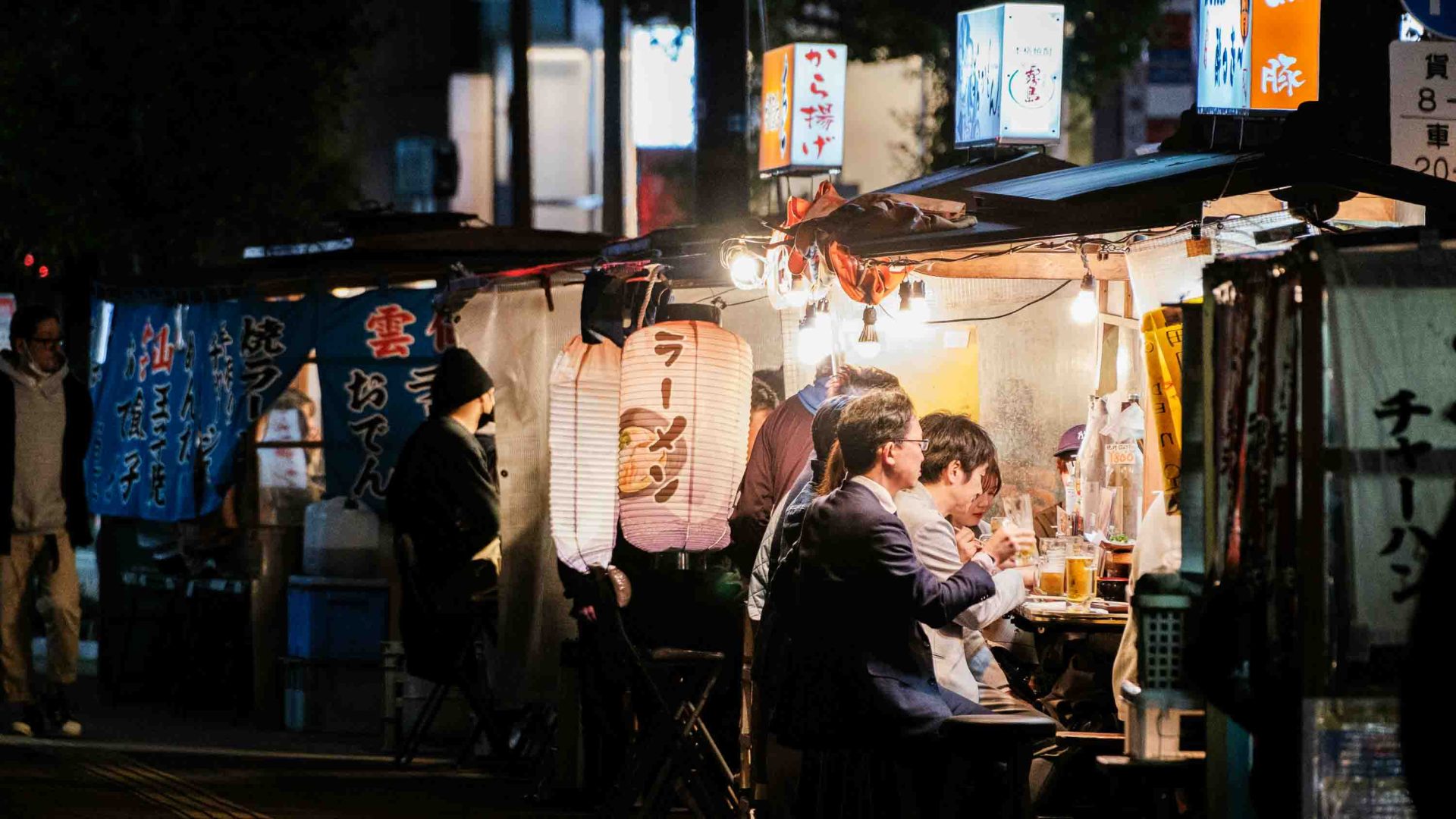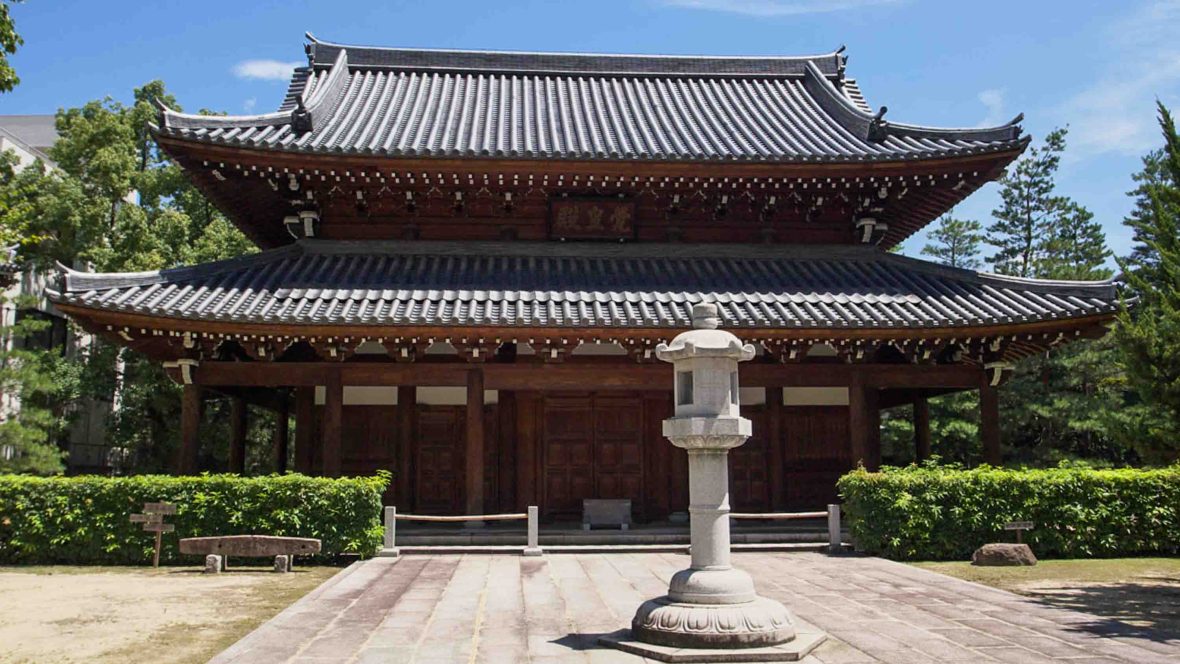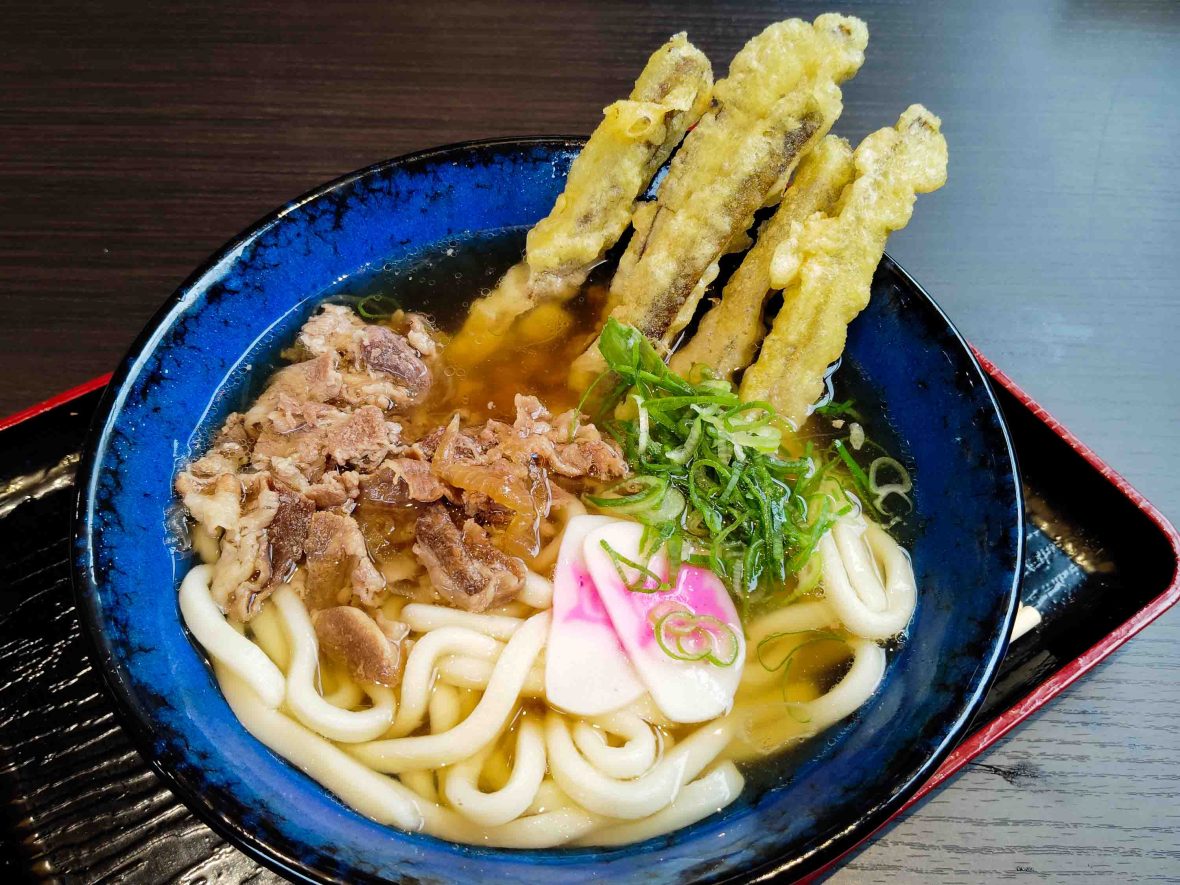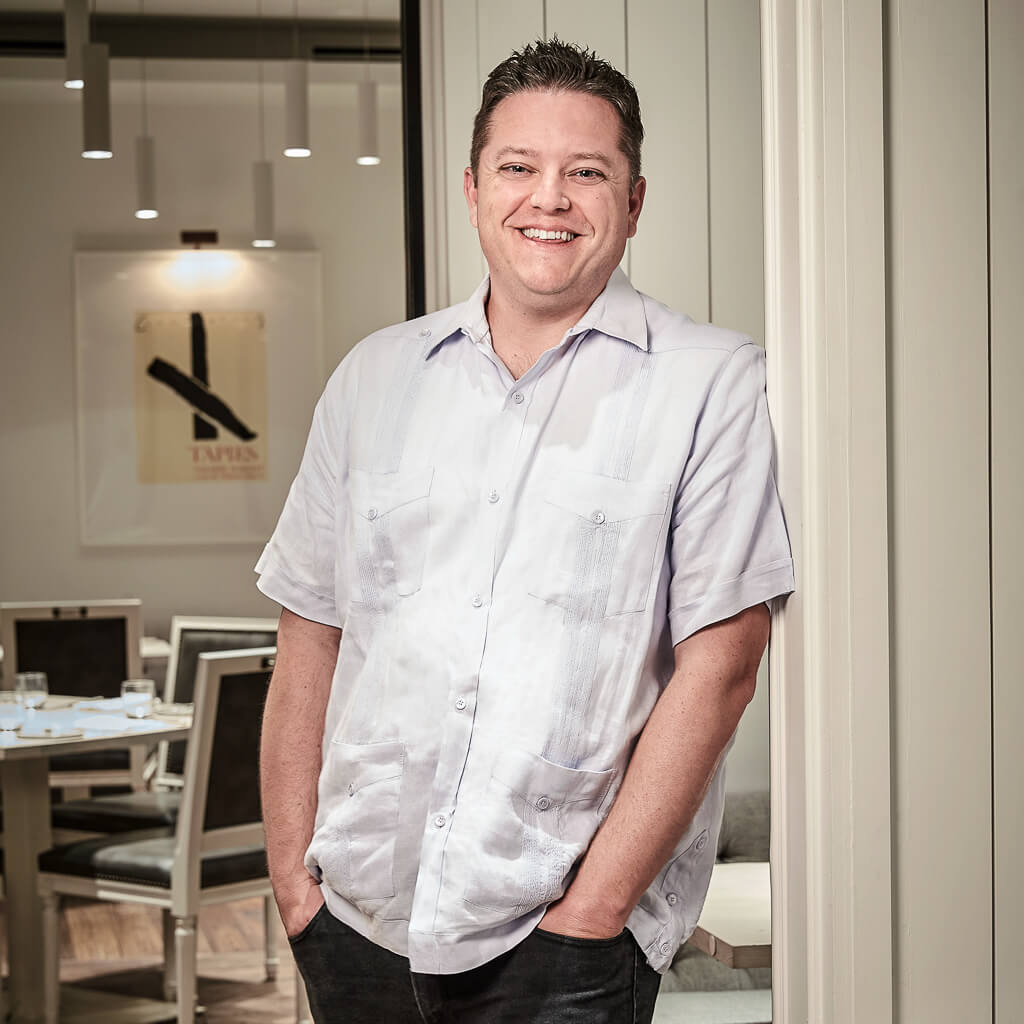
With strong claims to the origins of ramen, udon and soba, modern-day Fukuoka is considered Japan’s ‘city of noodles’. Writer Sarah Gillespie takes us on a slurping, seriously soupy pilgrimage.


With strong claims to the origins of ramen, udon and soba, modern-day Fukuoka is considered Japan’s ‘city of noodles’. Writer Sarah Gillespie takes us on a slurping, seriously soupy pilgrimage.
My fingers hover over the glowing buttons, trembling with suppressed hunger. It’s a pachinko arcade machine, but the prize is noodles. A laminated card stuck to its side lists English translations: ‘ramen (softer)’; ‘ramen (hard)’; ‘ramen (very hard)’. I punch the ‘ramen (hard)’ button, hand my ticket to the chef and wait.
In mere minutes, I collect my winnings in a melamine bowl. Globs of fat quiver on the surface as I set it down. Slivers of pork and spring onion, sliced as thin as washi paper, hang suspended in a cloud-like broth. I dive in, feeling the oil and salt coat my tongue, joining the chorus of slurping families, teens and suited-up businessmen. Noodles have always been the great leveler.
This is Hakataya Kawabata restaurant in Japan’s Fukuoka city. Famous for its JP¥290 (USD$2) ramen, one of the cheapest in the city and, some say, in Japan. The restaurant serves Hakata ramen, also known as tonkotsu ramen, a bowl of noodles in a pork bone broth that has been simmering for hours, or even days, sucking every gram of umami from the marrow.
The other feature of Hakata ramen is the thin noodles. “People in Fukuoka were short-tempered; they couldn’t wait for their noodles to boil,” jokes my guide, Manami Ofuchi.
There’s a lot to learn about noodle practices, and Manami walks me through the kaedama (refills) and high broth-to-noodle ratio that distinguishes Hakata ramen from other types. But thanks to its popularity abroad, to the average international diner, Hakata ramen is ramen—and it was invented here in Fukuoka. Also known locally as Japan’s ‘city of noodles’.
In the corner, Junko Shiraishi is turning pork skewers on what must be the world’s tiniest barbecue. In front of us, her husband Koki is crimping a hitokuchi (one-bite) gyoza so kawaii (cute), I want to scoop it up in a Pokéball.
Before merging in 1889, Fukuoka was two towns divided by the Naka River: Fukuoka, a former samurai stronghold turned fashionable downtown; and the merchant town of Hakata, home to traditional artisans and temples.
As the closest major port to Korea, Hakata regularly intercepted new ideas from travelers to mainland Asia. Of these, the most significant was the 13th-century Zen Buddhist missionary Shoichi Kokushi. Shoichi returned from China’s Song Dynasty with new knowledge of flour milling techniques that he adapted to make udon and soba noodles.
Hakata’s Old Town, with its pleasant muddle of Buddhist temples and Shinto shrines, is my first port of call. The syrupy scent of golden wintersweet blossoms perfumes the air as I meander past brushed Zen gardens and through camphor-wood gates, finally ending up at Jotenji Temple, founded by Shoichi in 1242. In a modest courtyard, veiled by pine trees, there are three carved stone stelae slabs. The leftmost is the city’s official Monument to Commemorate the Origin of Udon and Soba Noodles: “[Shoichi’s] great achievement in teaching Japan these recipes and milling techniques,” reads the accompanying plaque. Never before has a history lesson made me so hungry.

At night, Hakata looks entirely different. On the island of Nakasu, bisecting the Naka River, the air fills with the savory smells of yatai: street-food stalls on wheels. Lanterns lure hungry travelers behind noren curtains and under their light, the river gleams like red lacquer.
You won’t see yatai stalls during the day. “The yatai are set up every day, and taken down every day,” says tour guide Marisa Tashima. “Sometimes I walk by a garage and see a yatai folded up.” Despite their portability, however, they open every night in the same place, making them easy to find using the city’s official map.
Yatai first emerged around 1800 as a fast-food concept, and the craze quickly took off. According to Marisa, the ‘golden age’ of Fukuoka yatai was the 1960s, when there were around 450 stalls operating in the city.
Inevitably, the crackdown began. “Sanitation was a real problem,” she says. But unlike in other Japanese cities, Fukuoka’s local government eventually relented. “They realized the yatai could actually benefit Fukuoka, and created rules and regulations to help them survive,” says Marisa.
These days, there are around 100 yatai in Fukuoka. We stroll along the riverside, where columns of dashi-infused steam rise from mobile kitchens; I inhale the scent of deep-fried garlic, boiled eggs and tonkotsu. It’s said that Hakata ramen itself was invented at a yatai, in 1937.
Marisa’s favorite yatai isn’t on Nakasu, which is busy and tends to “churn through customers,” she says. Crossing the bridge to the Tenjin neighborhood, we arrive at Chusuke Yatai where we draw aside a red noren and step into a restaurant in miniature.
In the corner, Junko Shiraishi is turning pork skewers on what must be the world’s tiniest barbecue. In front of us, her husband Koki is crimping a hitokuchi (one-bite) gyoza so kawaii (cute), I want to scoop it up in a Pokéball. Though they do serve Hakata ramen, Marisa and I instead opt for their specialty oden: eggs, daikon radish, fish cakes and tofu stewed in a light soy broth, washed down by Asahi beer in a metal tumbler beaded with condensation.
I order this classic Fukuoka dish and receive a bowl of tender udon noodles sprinkled with crispy burdock root tempura. The broth, they tell me, is made from kombu seaweed and three different types of fish. I take a sip; it tastes like the sea.
While Hakata is concerned with preserving the past, on the Fukuoka side of the river, you’ll find venues nudging the city’s culinary traditions into the future. At industrial-chic bar Citadel, in the swish neighborhood of Daimyo, bartender Seiryu Matsuoka is stirring spirits with the precision of a lab technician.
Most cocktails on the menu reference Japan or Fukuoka in some way: yuzu chili paste gin, matcha chocolate, craft sake from Fukuoka’s LIBROM brewery. But of particular interest to noodle lovers are the experimental liqueurs, scrawled with hand-written labels and infused with common Japanese ingredients.
Flipping through the hefty menu, I find oil sardine gin, miso vodka, and mentaiko (Fukuoka spicy cod roe) whisky. I try the goboten whisky, infused with burdock root, and burst out laughing at its strangeness, at the slap of umami and sizzle of oak-soaked alcohol.
It’s the perfect aperitif before the real thing: goboten udon. At Tachi Nomi To Udon Minori Daimyo (Seiryu’s recommendation), I order this classic Fukuoka dish and receive a bowl of tender udon noodles sprinkled with crispy burdock root tempura. The broth, they tell me, is made from kombu seaweed and three different types of fish. I take a sip; it tastes like the sea.
Also in Daimyo, you’ll find the very first branch of an international ramen sensation. Shigemi “Ramen King” Kawahara launched Ippudo in 1985; there are now more than 200 branches worldwide.
“I went there as a girl in the 80s; it was very stylish to go,” Manami tells me. “Before, ramen was known as more smelly and dirty; Ippudo made it fashionable and helped to spread it around the world.”

The perception may have changed, but Ippudo’s ramen is still delightfully funky, with a tonkotsu that’s simmered for 24 hours. I order the ‘Shiromaru Classic’ with all the toppings—lashings of seaweed, sprinklings of spring onion, a gooey ramen egg.
As I gulp up the thin noodles, I think of how the impatience of Fukuoka diners helped produce this sublime dish and keeps the yatai fast food tradition alive. I think of the eagerness of Shoichi Kokushi to share the secrets of udon and soba, and the haste with which Shigemi Kawahara exported ramen around the world. In Fukuoka, it seems, impatience is a—delicious—virtue after all.
****
Adventure.com strives to be a low-emissions travel publication. We are powered by, but editorially independent of, Intrepid Travel, the world’s largest travel B Corp, who help ensure Adventure.com maintains high standards of sustainability in our work and activities. You can visit our sustainability page or read our Contributor Impact Guidelines for more information.

Sarah Gillespie is an award-winning travel writer based in Glasgow, Scotland. She has written for The Sunday Times, The Guardian, and National Geographic Traveller UK, and has appeared on BBC Scotland and multiple podcasts. She enjoys whisky and adobo, occasionally at the same time.








Can't find what you're looking for? Try using these tags: